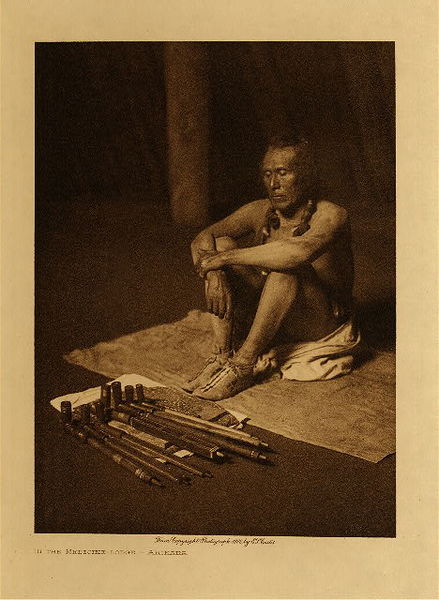Edward S. Curtis (1868-1952)
View Artist Biography
Title:
In the Medicine Lodge - Arikara
Date:
1908
Size:
Volume, 12.5 x 9.5 inches
Medium:
Vintage Photogravure
The healers of disease were usually men belonging to the medicine fraternity, but such membership was not essential. In the treatment they used many herbs in connection with the universal incantation; but each herb employed was supposedly possessed of spiritual strength, and the knowledge of its potency with the right to use it was acquired by each medicine-man through revelation, inheritance, or purchase from some other medicine-man. Each acquisition, whether a plant, an animal, or instruction as to method, was an added unit, one more medicine. The more of such possessed by an individual the greater was his standing in the eyes of the tribe. Medicine-men procured many of their medicines by sending their wives as emissaries to men possessing the desired power, a practice common to various other tribes, as the Mandan, Hidatsa, Apsaroke, and Cheyenne.
In treating his patient a healer usually remained four days, not singing, but smoking and praying much to his spirit helpers. If no improvement was apparent, he departed and allowed some one else to attempt a cure, but if progress was made under his ministrations, he usually remained until the patient could move about. After the recovery and before his departure the healer sang his medicine songs, in thankfulness for the success of his efforts. In short, the treatment was a combination of mental healing, primitive therapeutics, and massage.
In treating his patient a healer usually remained four days, not singing, but smoking and praying much to his spirit helpers. If no improvement was apparent, he departed and allowed some one else to attempt a cure, but if progress was made under his ministrations, he usually remained until the patient could move about. After the recovery and before his departure the healer sang his medicine songs, in thankfulness for the success of his efforts. In short, the treatment was a combination of mental healing, primitive therapeutics, and massage.
